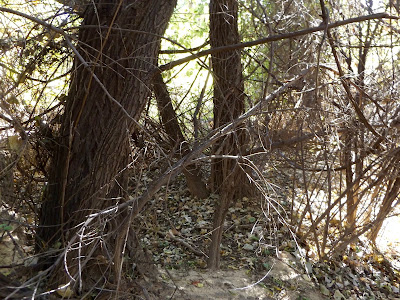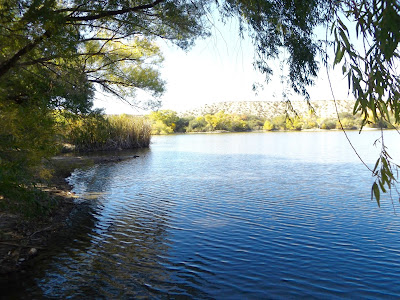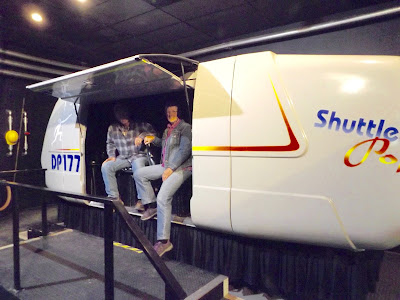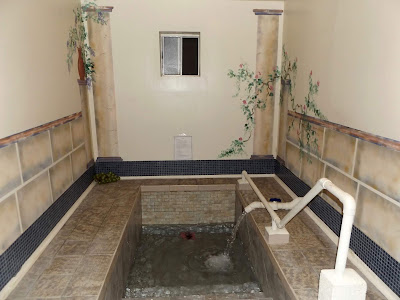October 29, 2019
When I am away from home for a spell, it becomes obvious that I depend somewhat on a routine of sorts to measure time. Seems that whether I am aware of it or not, the days and hours are marked as passing in a stream of sleepings, meals, chores and activities.
On the other hand, when I am not at home, the passage of time is entirely changed: it’s easy to lose track of what day it is or the march of hours throughout the day. It almost feels as if I am given extra time, which gets me to wondering if I am doing too much of filling days with minutiae. Maybe that is my motivation to reorder how I spend my time . . .
King cotton. . .
It doesn't take a discerning eye to know that in southeastern Arizona, we were in cotton country: besides a couple of small alfalfa fields, we have seen no crops but cotton. In fact, surprisingly, we have seen zero home gardens, which surprises me.
I always have an interest in agricultural pursuits. Even though I have spent lots of time around cotton harvests, I am enjoying seeing the changes that have evolved in the process.
The field pictured below has been harvested and the stalks are being mowed and mulched prior to being disked in.
At some previous time in another place, I saw the huge harvesters that roll the cotton into gigantic plastic-wrapped round bales, but I had never seen them getting picked up from the field.
I regret that the next photo does not clearly show the fascinating process, so I will explain. The bales are deposited field-side in rows of four, the number that fits into trucks designed especially for the unique purpose. The truck backs up to a row and tips its bed similarly to a dump truck. A conveyor ramp extends out of the truck bed while tracks below move the truck backward into the row of bales as the conveyor transports them into the truck. The bed levels back out to to get the tracks off the ground and away it goes to the gin. Ingenious! But what expense for a one-use machine that is employed only at cotton harvest! It must save enough money to be worthwhile.
Pioneers & loved ones . . .
As always when we are in that region, we paid our respects to my sister-in-law Sharon and to her ancestors who are interred near Thatcher. Sharon's folks came to Graham County in the late 1800s. Her great great grandparents were from Denmark: fascinating folks who were among the renowned Mormon handcart pioneers.
Peter O. Peterson was four years old when his family immigrated to New York on the ship "Thornton" in 1856. Typically, the European LDS converts would travel by rail to Iowa, the end of the line, and then by wagon to Utah. Because funds were sometimes insufficient for full outfits of teams and wagons to transport the incoming pioneers, the handcart movement was devised.
The large two-wheeled carts were literally pulled by a person walking between two long forward-facing poles. They were utilized for about four years in the mid-1800s. Family members walked alongside; the family's provisions were carried in the carts as they made their way to Utah Territory.
Because of various companies' late-in-the-year starts, they were caught by severe winter weather, which resulted in some individuals perishing and others saved by dramatic rescue efforts. It was a punishing journey under even the best of circumstances.
At age four, Peter Peterson was the second youngest of six children in his family to make the trek. Ten others were eventually born to his parents. His wife, Mary Anderson, was also Danish. She and her family utilized steamship and wagon to journey to Utah. Mary & Peter met while answering a call for pioneering in Arizona, and married along the way. Their continuing story is fascinating, but best saved for another day.
As we were lodging in an old farmhouse in the region where they resided, I suddenly wondered if this house could actually have been theirs or have been the home of family. Checking back in my records, I saw that by 1920, they had a home in Thatcher in addition to at least the 154 acres Peter had homesteaded in 1900 and presumably farmed.
According to the census, he and Mary resided in the tenth house from the northwest corner of Thatcher's incorporated area. I really wish I could say we followed that hint and found their house; however, it was not that easy. First off, it didn't say if the enumeration was in a southerly or an easterly direction, so we tried both. One way, the tenth house appeared to be of a more modern vintage. In the other direction, there were vacant lots which made it difficult to tell which house was tenth, and actually, nothing stood out and called to us, leaving us not knowing. Dang - another bright idea shot down!
We have visited these graves before, of course, and I had always assumed that Mary's middle initial stood for her maiden name of Anderson, but now someone has actually used a marker to transform the A to an E. I have never encountered such a thing on a gravestone - very odd. I don't know of a middle initial or name for her, so have no idea what that is about.
The symbol pictured below is attached to their tombstones to designate them as handcart pioneers. That creates a dilemma which I might work on because the information I have does not indicate that Mary's family were handcarters.
Dankworth Pond, Alaskan, connections . . .
Despite strong winds continuing, we stopped off for a walk at one of my favorite places: Dankworth Pond, then its nearby neighbor, Roper Lake. While there, we had a nice long chat with a fellow from Alaska who was on his way to our very own Prescott, where his friends reside. The icing on that connection would have been if we knew his friends, but we do not.
Dankworth is filled by warm artesian water, a common commodity in the Gila Valley.
I have neglected mentioning our bird list for this trip, so here's a good place to start. Earlier than this stop, we got raven, dark-eyed junco, great-tailed grackle & phainopepla. At Dankworth, we added American white pelican (flying overhead - on its way to Prescott?), American coot, ruddy duck, northern pintail, American wigeon, red-winged blackbird, cinnamon teal, lesser scaup, pied-billed grebe & ring-necked duck.
The wind was whipping at a pretty strong clip, as it did for much of our stay.
In a loop around Roper Lake, we saw a couple of great blue herons. Others around the region included Gambel's quail, collared dove and mourning dove.
A desert monastery & other random finds . . .
A wandering drive across the desert took us to the entrance of the St. Paisius Orthodox Monastery, a women's coenobitic (I had to look it up, too) community, which follows the traditional rule of Serbian monastic life. In our previous stays in that area, we had never heard of the place. We considered visiting; however, we were not dressed appropriately - skirts and head coverings necessary - and when we arrived at the entrance, we found it less than inviting. The gate is closed and one must utilize a call box to request entrance. Next time, I will be better prepared; they do seem to allow guests onto the grounds, so it might be an interesting stop.
As usual, though, we found other things of interest along the way. I think the cactus pictured below is a staghorn; there was an astounding vast forest of it that stood out because of the proliferation of bright yellow fruit.
Our route was along the very dusty washboardy Artesia Road. As we left from the cutoff to the monastery, we saw what seemed to be a burying ground. Upon inspection, we found a signpost pointing the way, and possibly one of the oddest cemeteries I've seen.
Graves there are randomly and haphazardly located in a small area with no entrance, no drive, no nothing at all. Some are individually primitively fenced, but most are not. The only thing to mark it besides the post at the turnoff is an American flag standing out in the stiff breezes that often flow across that landscape.
Always, the curiosities get my attention. So often, we find evidence of those who have been before us and so often, I wonder about their tenure - who they were and why they ventured to the places they did.
I called another halt to the drive when I spotted a remnant of a concreted rock wall that seemed to be apropos to nothing, so naturally, we must disembark and take a look.
As best as we could discern, the wall was built as a stand-alone structure to secure the end of a large dirt dike from eroding. The dirt embankment created a tank that would trap runoff water for livestock and game.
Those who built it had inscribed their names, dates (in 1937) and homes in New Mexico.
We walked around the dike and bushwhacked our way back through the extensive vegetation that has thrived because of the water catchment. It made quite an arty photo in the bottom where plants are growing in the cracks left behind by the mud drying.
Cluff Ranch, non-fishing, duckwalking . . .
We had previously enjoyed visiting at Cluff Ranch, a once-thriving livestock operation that is now maintained as a wildlife preserve. As clear evidence of our overly-consumed and discombobulated states of mind lately, I left my fishing license at the B&B even though our full intention was angling. Perhaps not sleeping well contributed to my fatigue, so I was not helpful when Chris was packing the truck, so a wholly insufficient amount of drinking water went with us. My sunglasses were nowhere to be found, and oh yes, that was that little bait mixup - it was still back in Prescott. Other than those bloopers, we were totally on top of things.
Never mind about the bait - the señor didn’t want to do his fishing solo and I certainly wasn't taking a chance at fishing without a license. The weather was perfect and I was fairly easily persuaded that a hike around the lake was the perfect solution to everything, and so it was.
Well, there was that one mishap wherein I crashed my head into a low tree limb so hard that I nearly fell backward onto my keister. That section near where Ash Creek flows into the lake was next to impenetrable with tangled brush and downed trees so much that we thought we might not find a way through.
With my sacrifice of leading with my head while duckwalking through the thicket, we managed to scramble along until the going got better and we could enjoy the beauty around us.
Cluff Ranch spreads out along the north flank of majestic Mt. Graham. That pretty well precludes any attempt at sawanboori on my part for Ash Creek; I suspect the stream's headwaters are far up in that rugged wilderness. For perspective, Chris informed me that the height of Mt. Graham is one-third more than the depth of Grand Canyon.
New birds at Cluff Ranch included mallard, blue-gray gnatcatcher, northern harrier (very interesting watching him hunt as he swooped at vegetation level back and forth until he came up empty and disappeared behind an embankment) & black phoebe.
We polished off our day with more wandering - down a dry creek bed that that challenged our footing and netted us a few more birds on the trip list - a bright and beautiful northern cardinal, ruby-crowned kinglet and Bewick's wren. On the drive back from the ranch, we spotted an impressive loggerhead shrike giving us an extended look as he perched atop a creosote bush, and a juvenile red-tailed hawk hanging out on a power pole.
I was very impressed with the bleached bones of this towering cottonwood that stood starkly against the clear sky.
Space shuttle, ranarium, more . . .
Obviously, this little foray of ours lacked focus of any kind except to be away. In the process of doing very little, we heard about the Discovery Park facility that is now an adjunct campus of Eastern Arizona College and decided to give it a gander.
Our arrival was timed perfectly: we were the only people present (that alliteration made me want to follow up with purple people eater), so received special personal (purple people eater) tours of some of the oddly varied collections that, including a personal (purple people eater - and I'm not even on pain pills) conglomeration of native American artifacts that were dug up by a couple back in the day when such activity was not illegal. To their credit, they donated the whole extent of it - a very impressive bunch of stuff, even many huge pots which they had pieced and glued back together.
And . . . we had a ride through our solar system on a space shuttle simulator; Chris termed it a bit on the hokey side, but I actually learned a good bit about various planets. There was some concern about my tendency toward motion sickness while being buffeted about inside there and watching a screen of fast movement, but I emerged unscathed.
Pictured below are some of the places we visited.
As long as we had the grounds to ourselves, we took advantage to explore. When we spotted a walking bridge across a pond that is maintained to study threatened (by whom?) Chiricahua leopard frogs, we embarked on a risky proposition. We did not know until we were in the middle of it that the catwalk was broken and falling apart. Because it took us to an island, it was the only way back; I kept a firm hold on the rope handholds in case the structure was inclined to fall out from under me, but had no idea if the ropes would hold me up in any case, and if it had and if they did, what was I going to do then but hang there by my armpits until a helicopter could be summoned to rescue me?
In the end, by careful maneuvering, we got to the island and back, but nary a Chiricahua leopard frog did we spy. Perhaps their threateners had arrived before us . . .
. . . although the lone mallard that inhabits the ranarium (yes, I learned something else - a ranarium is a place for keeping or rearing frogs) approached ostensibly for a handout and when one was not offered, plopped himself back into the water with his companions - two coots, not counting the one old coot who was my companion.
A not-so-bright idea . . .
Because Mt. Graham is the site of an important international observatory with three telescopes and one of the largest in the world, it is important for the surrounding area to be free of ambient light that would affect its work.
Toward that end, all lights are carefully shielded in order not to illuminate anything beyond their intended subject. I was very impressed with Safford's street lights, which leads me to wonder if they can manage not to light the night sky, why every other place can't do the same? The answer is, of course, that every other place could do so if they chose to enact and enforce a dark sky ordinance, such as Safford has and the same as Flagstaff has due to its Lowell Observatory.
As it turns out, Prescott and Yavapai County also have dark sky regulations; however, I see no or little enforcement of them.
A Flagstaff astronomer explains that a dark sky law is "not an effort to take away lights people need, rather, it tries to eliminate poor lighting practices that direct lights into the sky or into people's eyes, waste energy and interfere with astronomy". In fact, it would seem that the state requires all local governments to have an ordinance that protects night-sky viewing, which leaves me wondering why it's not more of a priority and disappointed that it's not. I can't even get our own HOA to enforce its lighting ordinance. I scratch my head in disbelief that so many folks feel a need to light up the world.
Below is a photo of Safford's answer to lighting what needs to be lighted while preserving a dark sky:
Hot springs . . .
Well, it was our 40th wedding anniversary and while it wasn't a two-week stay on a tropical island, we marked the occasion with a pamper session at Kachina Mineral Springs, one of our favorite spots.
We relaxed to the nth degree in our private tiled room tub with perfect temperature mineral water. Kachina is a unique place utilizing the local bonanza of hot springs that proliferate throughout the Gila Valley.
Hearing the therapists talk about another local hot spring I had never heard of led me to do a little research. I found interesting information about Indian Hot Springs, where a luxurious hotel and spa had once been. The hotel has since burned, but its large and unusual pools remain, evidently available to those in the know, a group to which I unfortunately do not belong.
Interesting that the rock group, The Rolling Stones, not only visited Indian Hot Springs, but became at least partial owners of the property and were the inspiration for the guitar-shaped pool there. Now that I know about it and know that I can't get in, I want to more than anything. We shall see . . .
Coming home, Roosevelt Lake . . .
The clever señor suggested that we forego the big cities route for our trip home, so we came the "back way" as I call it, through more beautiful mountain country than you can shake a stick at, skirting around Roosevelt Lake, through Payson (what happened to that quiet retreat on the Mogollon Rim?), and along the flanks of the incredible Mazatazal Mountains and wilderness.
Every mile gave me more pause as I recalled past forays that I need to be out in that magnificence and spending much less time indoors.











































No comments:
Post a Comment